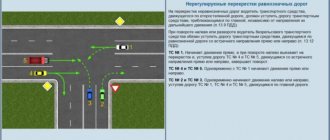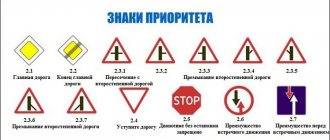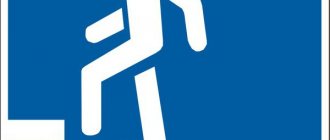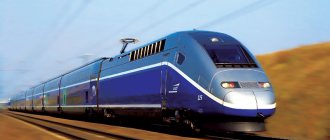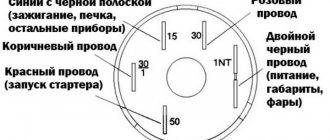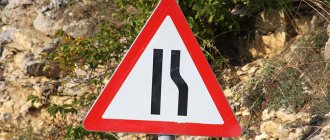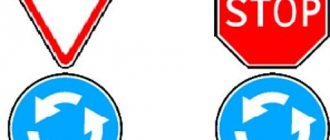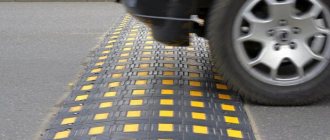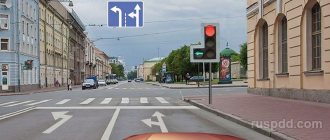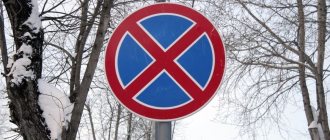Drivers are required to know the rules of the road not only regarding the passage of various sections of the road, but also the presence of road markings and installed signs. This will help not only avoid possible fines, but also unwanted damage to the car.
The interpretation of prohibitory signs often raises questions, one of which is the “No Traffic” road sign; in the traffic rules it has the number 3.2. Previously, this index had a different name.
We inherited most of the existing signs in the Russian Federation from the Soviet Union. In connection with the modernization of the entire road system, some concepts are periodically adjusted in accordance with international standards. In this regard, the road sign “No through passage” was renamed into a prohibitory sign “Traffic prohibited”. In this way, its true meaning was emphasized and discrepancies were eliminated.
It is worth carefully familiarizing yourself with the current interpretation of the concept, otherwise you will have to regularly pay a fine for driving under the “No Passing” sign. It is important to understand which section of the road it belongs to, and what specific actions it does not allow on the part of drivers.
You need to know that sign 3.2 is not allowed to be installed before turning onto a one-way road. Although this opinion is not uncommon among drivers.
Purpose
Mandatory signs indicate the permitted directions of movement, the minimum permissible speed, and for certain groups of vehicles the permissible route of movement.
The blue color may confuse the driver. How, you ask? If we recall other groups of signs, for example: prohibitory and warning signs, which have a red border, the driver has a subconscious understanding that red is the color of danger, prohibition or restriction. Here the background color is blue, and the signs themselves are taken less seriously, and many drivers generally think that they are only advisory in nature, since they do not prohibit anything. But that's not true! And we will see this a little later.
Now, in order...
Punishment for a driver who turns his car around at a pedestrian crossing
A crosswalk is designed to allow a pedestrian to cross the road without the risk of being hit by a passing car. At crossings without traffic lights, a pedestrian has priority over a motorist.
It is not surprising that a U-turn at a pedestrian intersection or other place where this action is not supposed to be performed can cause an accident.
This is stated in Art. 8.11: “Turning is prohibited on ... pedestrian roads.”
The punishment is imposed under Article 12.14 of Part 2 of the Code of Administrative Offenses. If the driver turns around or backs up where it is prohibited, he will be fined 0.5 thousand rubles.
And if he turns around in a technological gap in the main dividing strip, the fine will increase fivefold - up to 2.5 thousand rubles. We will talk about the punishment for driving in the oncoming lane of one-way traffic later.
You cannot turn your car around at a pedestrian crossing.
Permitted directions of movement
Signs of this subgroup allow movement only in those directions that correspond to the arrows on the sign.
At first glance, everything is simple, but there are some subtleties.
1. The action applies only to the intersection in front of which the sign is installed (see figure below). 2. The action does not apply to route vehicles. 3. If the sign allows a left turn, then a U-turn is accordingly allowed.
These rules apply to all 6 pointers of this family, but I will tell you about the features of using the first of them 4.1.1 separately. Sign 4.1.1 allows you to move only straight, but there are 2 installation options here:
- If a sign is installed before an intersection, it will only be valid at the first intersection of the roadways of that intersection.
- If the sign is placed after an intersection or on any other section of the road, it will be valid until the next intersection in the direction of travel. That is, it will prohibit any turns (left, right), U-turns; as an exception, only turns into the yard or into the adjacent territory located on the right are allowed. In simple terms, when seeing such a sign, the driver should behave as if a solid or double solid marking was drawn on the road as a center line.
Installation cases
The appearance of the sign is a white circle edged with a red line around the perimeter. There are no symbols inside the circle. In some cases, it is supplemented by information signs located directly below it. They can indicate the interval of action, duration of action, etc. Installation is provided in the following cases:
The traffic rules of the Russian Federation provide for a number of prohibitory signs that introduce or cancel a list of restrictions on the driving conditions of a vehicle. One of them is sign 3.2 - “traffic prohibited”. As with any violation of traffic rules of the Russian Federation, the Code of Administrative Offenses regulates the fine for driving under a “no traffic” sign.
For cyclists and pedestrians
The beginning and end of the bike path. Let me draw your attention to the fact that pedestrians can also use this path for movement, but I recommend doing this, as a last resort, only in the absence of a sidewalk; you understand, cyclists can reach high speeds and “meeting” with him does not bode well for a pedestrian.
Footpath. Cyclists can also use it, but only if there is no bicycle path, as well as a road where they have the right to move along the side of the road or the edge of the roadway.
The beginning and end of a combined bicycle and pedestrian path without separation, that is, with combined traffic.
These signs indicate the beginning and end of a combined path, with mandatory separation of cyclists and pedestrians. Moreover, this division must be made structurally (for example: a lawn or a curb) or in the form of a continuous marking line.
More about signs
Railway crossing with barrier
This sign is placed in front of a railway crossing that has a barrier.
Railway crossing without barrier
Installation is carried out in front of a railway crossing that does not have a barrier.
Railway
Installation takes place just before the move. There are several types depending on the number of railway tracks.
Moving
This is a whole subgroup of signs. They warn about approaching the railway outside the boundaries of settlements.
Tram rails
Informs about the intersection of roads and tram tracks.
The tram always has an advantage over cars, except for the moment when it leaves the depot.
Intersection of equivalent roads
It is placed on sections of roads, near which there is an intersection of equivalent roads. Overtaking at such intersections is not permitted.
Roundabout Circulation
Symbolizes the approach of a roundabout.
These sections intersect in accordance with traffic regulations.
Traffic light regulation
It is placed in front of a section of the road where traffic is regulated by a traffic light.
Drawbridge
Placed in front of the drawbridge.
Embankment
It is installed near the embankment of various reservoirs.
Dangerous bend
It is placed near a turn with a small radius of curvature of the road or a turn with poor visibility.
The line on it is rotated to the right or left. It depends on the direction of the turn itself. Also, the line on the sign may be s-shaped. This means that the turn that the sign symbolizes is also of this shape.
Steep descent
Signals a steep descent.
When descending on this section of the route, the descending driver must give way if there are obstacles on the descent.
The steep climb
Indicates that the road has a steep slope.
The descending driver gives way if there are obstacles on the roadway.
Slippery road
Symbolizes that what follows is a very slippery section of the path.
Rough road
It means that the motorist will be faced with a section of road with potholes, bumps and other irregularities.
Artificial hump
Placed in front of a speed bump.
Gravel release
It says that there may be crushed stones and small stones on the road, which can suddenly fly out from under the wheels of the car.
Dangerous roadside
It signals the approach of a too steep shoulder from which the car can literally fall.
Road narrows
Warns of very sharp narrowing of the road surface.
It has three different versions, warning about the narrowing of the entire road or its left or right parts.
Two-way traffic
Informs that there is oncoming traffic on the road.
Crosswalk
Signals that the motorist will soon approach the pedestrian crossing.
Children
Informs that a section of the route is approaching, near which there is an institution for children (school, kindergarten, etc.).
Bike Lane
Installed in front of the bike path.
Cattle drive
Placed where pets often cross the road.
Wild animals
It is placed where wild animals can run out onto the road.
Rockfall
Placed in front of sections of the road where rocks fall.
Side wind
It is placed in front of sections of the road that are blown by very strong winds.
You need to be prepared for skidding and leveling the car after it.
Aircraft
Warns that an airplane may fly low over the road. Placed near airfields.
Tunnel
Installed shortly before entering the tunnel.
Congestion
Placed in places where traffic jams regularly form.
Other dangers
It is placed where the driver may face other troubles that are not included in the main list of warning signs. For example, in places where thick fog often falls on the road, sharply impairing visibility.
Turning direction
Includes several signs of the same type and indicates where to turn at intersections, turns with a slight curvature of the road, as well as on routes to bypass repaired sections of the roadway.
